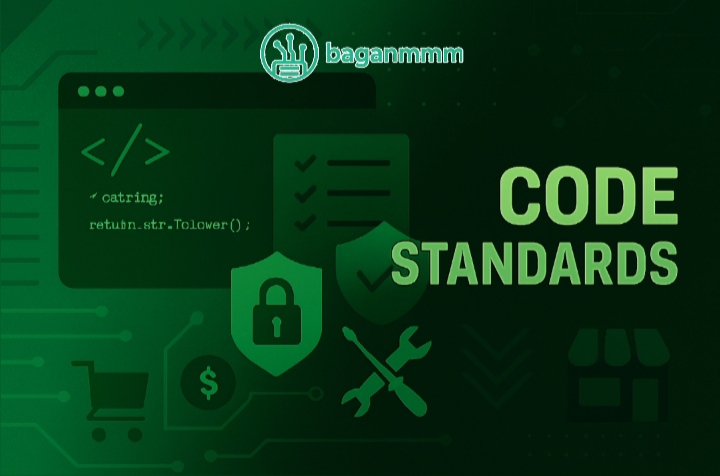If you are a senior‑level developer, you should have a solid understanding of code standards. In software companies, there are always established code standards. While each company may have its own variations, the core principles are the same. Code standards are not only important for every developer but also essential for every software company.

Having code standards makes coding faster, and it also makes maintenance and long‑term development much easier. Every developer may have their own personal style, but when working in teams, following a shared standard ensures smooth collaboration and better developer documentation. That’s why code standards are especially important for senior‑level developers.
Most software companies and enterprises also use tools to enforce code standards. These tools help improve code quality, error handling, debugging, security, integration, and CI/CD processes. Examples include SonarQube, ESLint, Pylint, and Codacy. Each tool has its own strengths and weaknesses depending on the programming language being used. Therefore, when choosing tools for code standards, it’s best to select them based on the language you are working with.
So, let’s dive deeper into the topic of code standards.
What Are Code Standards?
Code standards are a set of rules and best practices that define how code should be written, structured, and documented. Just as every developer may have their own personal coding style, software companies and tech teams also establish their own code standards.
Code standards are essential not only for software companies and tech teams but also for projects. A project’s security, stability, maintenance, and documentation can only be carried out smoothly and effectively when proper code standards are in place.
What Code Standards Include
- Syntax and Formatting
- Naming Conventions
- Error Handling
- Security Practices
- Documentation and Comments
- Versioning and Modularity
These standards can be language-specific (e.g., Python PEP 8, Java Code Conventions) or industry-specific (e.g., MISRA C for automotive, CERT for secure coding).
Individual developers may also have differences in coding style and thought process, which can lead to variations in standards. However, such differences can be unified using third-party tools.
Why Code Standards Matter
1. Readability & Maintainability
- Clean and consistent code is easier to read, debug, and extend.
- This is especially important for team-based or long-term projects.
2. Collaboration
- Standards allow teams to work together without confusion.
- They reduce merge conflicts and shorten onboarding time.
3. Security
- Secure coding standards (like CERT, OWASP) help prevent vulnerabilities such as buffer overflows, injection attacks, and data leaks.
4. Compliance
- Industries such as automotive, aerospace, and healthcare require coding standards for regulatory compliance (e.g., ISO 26262, DO-178C).
5. Scalability
- Standardized code scales better across modules, teams, and platforms.
- It also reduces technical debt.
These are the main benefits of code standards. There are additional advantages too for example, they greatly improve maintenance and developer documentation.
That’s why, as a developer, you should understand code standards and know how to use the tools that support them.
Below, you’ll find examples of code standards for specific programming languages.
Common Code Standards by Language
| Language | Standard / Guideline | Purpose |
|---|---|---|
| C / C++ | MISRA C / MISRA C++ | Ensures safety and reliability in embedded and automotive systems |
| Python | PEP 8 | Promotes readable, consistent, and community-aligned code |
| Java | Oracle Java Code Conventions | Supports enterprise-grade clarity, structure, and maintainability |
| JavaScript | Airbnb Style Guide, ESLint | Enforces clean syntax, modularity, and browser-safe practices |
| Go | Effective Go | Encourages idiomatic usage, simplicity, and performance |
| Rust | Rust Style Guide | Ensures memory safety, concurrency, and idiomatic patterns |
| PHP | PSR Standards (e.g., PSR-12) | Improves interoperability across frameworks and libraries |
| Swift | Swift API Design Guidelines | Maintains consistency and clarity across Apple ecosystem apps |
Secure Coding Standards
Security is no longer optional it’s a core requirement. These standards help developers write code that resists attacks:
- CERT Secure Coding Standards: Language-specific rules to avoid common vulnerabilities.
- OWASP Secure Coding Practices: Web-focused guidelines for authentication, input validation, and session management.
- ISO/IEC 27001 & 27034: Frameworks for secure software development lifecycle (SDLC).
Industry-Specific Standards
| Industry | Coding Standard | Focus Area |
|---|---|---|
| Automotive | MISRA C / ISO 26262 | Functional safety, embedded reliability, real-time systems |
| Aerospace | DO-178C | Airborne software safety, certification, mission-critical systems |
| Medical Devices | IEC 62304 | Software lifecycle management for regulated health systems |
| Finance | PCI DSS, OWASP | Secure transactions, encryption, fraud prevention |
| Defense | MIL-STD-498, CERT | Reliability, traceability, secure mission-critical operations |
| Telecommunications | ETSI, ITU-T Recommendations | Protocol compliance, interoperability, network resilience |
| Energy & Utilities | IEC 61850, NERC CIP | Grid automation, cybersecurity, SCADA system integrity |
| Public Sector | NIEM, FISMA | Data exchange standards, federal security compliance |
Why Code Standards Matter in the Software Industry
Code standards are rules that define how software should be written, structured, and maintained. They can be applied across different languages, teams, and industries, and they have an impact at every stage of the development lifecycle.
Having code standards not only reduces development time but also greatly benefits projects in terms of security, stability, and performance.
Key Benefits
1. Consistency Across Teams and Projects
- Ensures that code looks and behaves consistently, no matter who wrote it.
- Speeds up and simplifies onboarding for new developers.
- Reduces confusion and merge conflicts in collaborative environments.
2. Improved Code Quality and Maintainability
- Encourages clean architecture and modular design.
- Makes debugging and refactoring easier.
- Reduces technical debt over time.
3. Enhanced Security
Secure coding standards (such as CERT, OWASP) help prevent vulnerabilities like:
- Buffer overflows
- SQL injection
- Cross-site scripting (XSS)
They also ensure safe handling of user data and authentication flows.
4. Regulatory Compliance
Many industries require specific coding standards for legal and safety reasons:
- Automotive : MISRA C / ISO 26262
- Aerospace : DO-178C
- Medical : IEC 62304
These standards help companies pass audits and protect them from liability.
5. Scalability and Reusability
- Standardized code scales more easily across teams, modules, and platforms.
- Promotes reusable components and consistent APIs.
- Supports microservices, serverless, and multi-agent architectures.
6. Better Collaboration and Communication
- Shared standards reduce misunderstandings between developers, designers, and QA teams.
- Makes code reviews more efficient and constructive.
- Encourages professionalism and shared ownership.
7. Future-Proofing with AI and Automation
- Makes it easier to integrate AI-assisted development tools like GitHub Copilot or SonarQube.
- Enables automated code validation, refactoring, and documentation.
- Supports explainability and traceability in AI-generated code.
These are the main benefits of having code standards. There are additional advantages as well.
For example:
- They speed up project development time. Because code standards improve communication between developers, they make code migration and version control smoother and faster.
- They also make project handovers and developer documentation easier to understand and more efficient.
Future of Code Standards in 2026
As AI-assisted development and autonomous agents become mainstream, code standards are evolving to include:
- AI-generated code validation: Ensuring machine-written code meets human standards.
- Explainability & traceability: Standards for documenting logic in ML models and decision systems.
- Multi-agent coordination protocols: Guidelines for agent-to-agent communication and task delegation.
- Ethical coding frameworks: Emerging standards for bias mitigation, fairness, and transparency.
Tools like GitHub Copilot, DeepCode, and SonarQube are already integrating code standard checks into real-time development workflows.
Final Conclusion
By now, I believe you have a good understanding of code standards. In this blog, I’ve shared the tools I currently know and use.
To add further points:
- Having code standards speeds up development time.
- Because of consistency, it becomes easier when developers hand over or exchange projects.
- It makes developer documentation easier to create and read.
- For long‑term projects, it simplifies security, maintenance, and data processing, while also reducing costs.
- It makes teamwork faster and smoother.
In summary, for enterprise‑level projects, code standards are as important as life itself.
For junior developers, even if you cannot create your own code standards yet, it is essential to understand and follow the standards set by senior developers.
Alice is the visionary behind Baganmmm Tech, a platform he founded with a passion for demystifying the complex world of technology. As the Lead Technologist, he's often found in his home lab – a cozy, wire-filled sanctuary where ideas are born and code is meticulously crafted. His infectious enthusiasm and knack for explaining intricate concepts make him the go-to expert for everything from web development to emerging tech trends.
